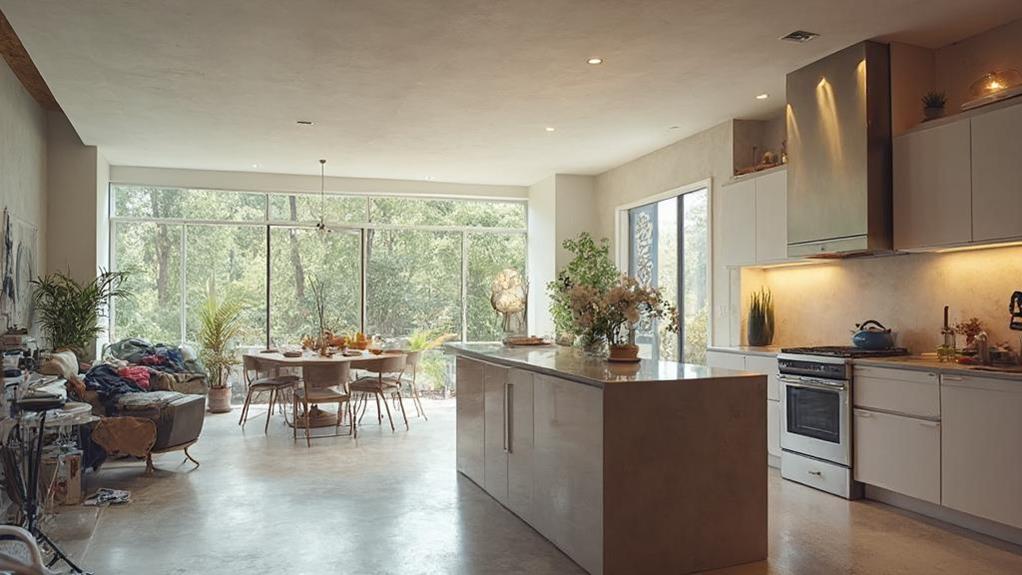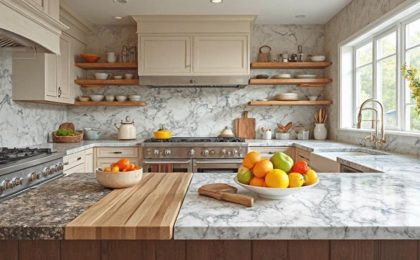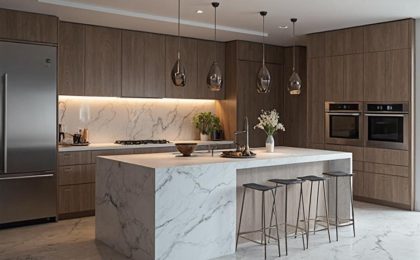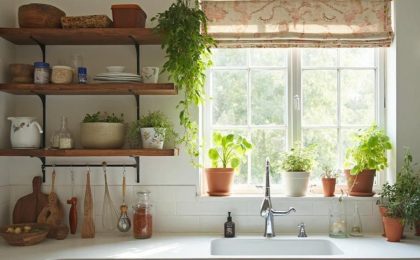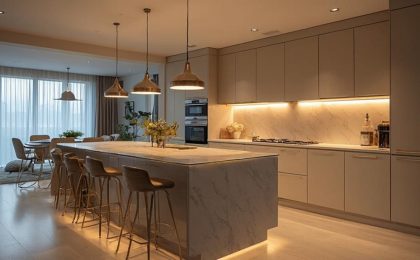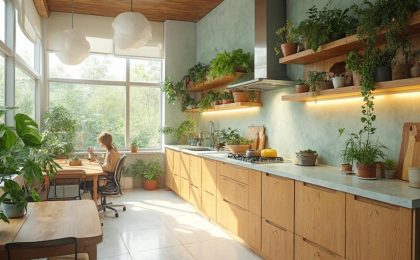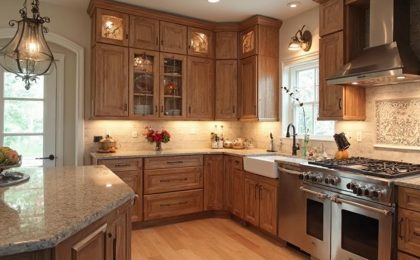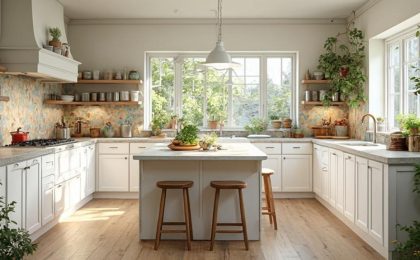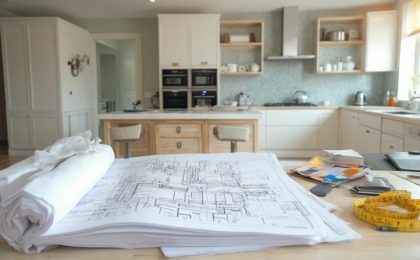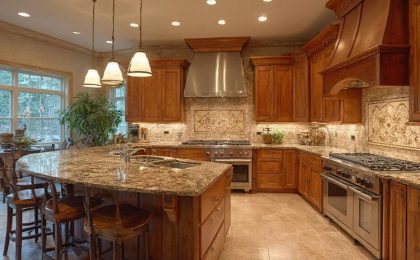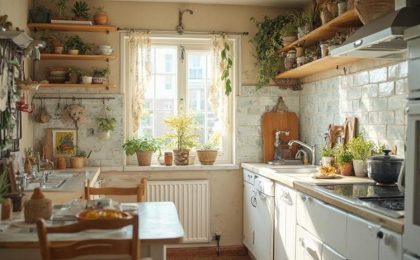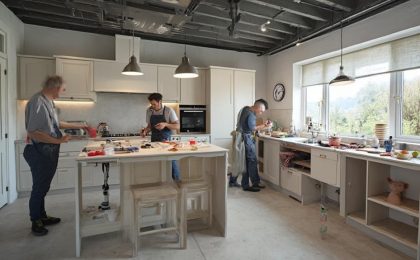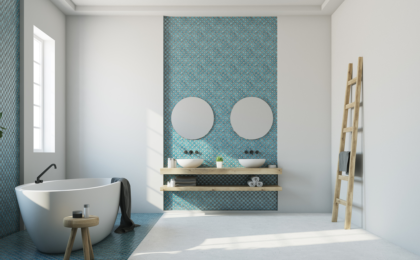When you consider an open-concept kitchen, you're looking at a blend of social interaction and modern design, but it comes with its own set of challenges. While you might appreciate the spacious feel and ability to entertain seamlessly, the potential for noise and lingering cooking smells can be significant downsides. It's essential to evaluate how these factors align with your lifestyle and preferences. As you weigh these aspects, you may start to wonder how they impact not just your daily life, but also the overall value of your home.
Key insights
- Open-concept kitchens enhance social interaction, allowing family and friends to engage while cooking and dining together.
- They improve cooking efficiency by providing unobstructed sightlines between prep, cooking, and dining areas.
- Cooking odors and noise can permeate the entire space, creating discomfort and distractions during meals.
- Lack of defined spaces can lead to confusion regarding task organization and visibility of clutter.
- Home value may increase in trendy neighborhoods, but not all buyers may prefer the open layout, affecting desirability.
Benefits of Open-Concept Kitchens
When you step into an open-concept kitchen, you immediately feel the flow of space that invites you to engage with family and friends while cooking. This seamless design blurs the lines between culinary creation and social interaction, making every meal a shared experience.
Imagine whipping up a gourmet dish while your loved ones gather around the island, sharing stories and laughter. In addition, choosing to invest in professional kitchen fitters can elevate the functionality and style of your open-concept design, ensuring that every detail is executed with precision.
Open-concept kitchens also enhance cooking efficiency. With everything in your line of sight, you can easily shift between prep stations, cooking areas, and dining spaces without feeling confined. This layout eliminates unnecessary barriers, allowing you to stay connected with your guests while you chop, sauté, and stir.
Moreover, the abundance of natural light that floods these spaces creates a warm ambiance, making the kitchen the heart of your home. You can experiment with trendy materials and fixtures, from sleek countertops to creative lighting, all while maintaining that inviting atmosphere.
In short, open-concept kitchens redefine how you experience cooking and entertaining, maximizing both efficiency and connection. You'll find that every meal becomes an opportunity for creativity and bonding, making your home feel alive and vibrant.
Drawbacks to Consider
While the allure of open-concept kitchens is undeniable, there are significant drawbacks that can dampen the experience.
First and foremost, noise control becomes a challenge. Cooking, entertaining, and family interactions all blend into one cacophony, making it hard to focus or enjoy a quiet moment.
Additionally, the lack of defined spaces can lead to confusion about where certain tasks should take place, which may hinder efficiency in the kitchen.
Then there are cooking odors that permeate the entire space, turning your cozy living area into a scent-saturated zone.
Privacy issues can also arise, especially if you have guests over. You might feel exposed while preparing meals, and conversations in the living area can easily intrude on your culinary creations.
Furthermore, clutter visibility can be a real concern; dishes piling up or a messy kitchen can negatively impact the overall aesthetic of your home.
For those considering a renovation, hiring professional bathroom fitters can further enhance the functionality of your space.
Lastly, maintenance challenges can become burdensome. With a larger, open space, cleaning requires more effort, and keeping everything organized can feel like an uphill battle.
The charm of an open-concept kitchen might come with a price, so weigh these drawbacks carefully before embracing this trendy design choice.
Impact on Home Value
The sleek allure of an open-concept kitchen has become a defining feature in modern homes, but its impact on home value can be a double-edged sword. While many buyers find the spaciousness and flow appealing, the actual effect on home appraisal can vary considerably based on market trends and regional preferences.
In addition, the aesthetic appeal of such layouts can be enhanced by professional tile installation, which guarantees compliance with building standards and contributes positively to the overall design.
When you're considering selling, it's vital to understand that not all potential buyers share the same enthusiasm for open layouts. Some may prefer traditional, compartmentalized spaces, which could affect your home's desirability.
If you live in a trendy neighborhood where open-concept designs reign supreme, you might see a boost in value. However, in more conservative markets, you could risk alienating buyers who seek distinct areas for cooking, dining, and entertaining.
Ultimately, aligning your kitchen's design with current buyer preferences can be key to maximizing your investment. If you're thinking of an open-concept remodel, it's wise to consult with local real estate experts to gauge how it'll impact your home's appraisal.
Design Tips for Success
Creating an inviting and functional open-concept kitchen requires a blend of thoughtful design and current trends. Start with layout optimization to guarantee a natural flow between spaces. Arrange your kitchen elements—cabinets, countertops, and appliances—so they're easily accessible and encourage movement.
Consider a kitchen island, which not only provides additional storage but also doubles as a social hub.
When it comes to color schemes, opt for hues that create a cohesive look across your adjoining spaces. Soft neutrals can open up the area and make it feel larger, while bolder accents can add personality without overwhelming the senses.
Think about incorporating textures through materials like wood and metal, which can evoke warmth and modernity simultaneously.
To enhance the visual appeal, integrate lighting that complements your color palette. Pendant lights above the island or under-cabinet lighting can create inviting spots that draw people in.
Don't forget to add personal touches, such as artwork or potted plants, which can bring life to your kitchen.
With these design tips, you'll create a space that's not just beautiful but also functional, making your open-concept kitchen the heart of your home.
Alternative Kitchen Layouts
Exploring alternative kitchen layouts can open up new possibilities for your home, especially if an open-concept design doesn't fit your lifestyle.
U shaped kitchens are perfect if you love a cozy cooking space, allowing you to work efficiently with everything within arm's reach. This design maximizes counter space and can often include a breakfast bar for casual dining.
If you prefer a more open feel without sacrificing function, L shaped kitchens provide a stylish solution. This layout offers versatile island configurations, where you can add seating or additional storage. It's ideal for both cooking and entertaining, creating a smooth flow between the kitchen and dining areas.
For those with tighter spaces, galley layouts are a game changer. These kitchens feature two parallel counters, allowing for a streamlined workflow, which is perfect for serious cooks who want to maximize efficiency.
Consider your lifestyle and how you use your kitchen. Each of these layouts offers unique benefits that cater to different needs, ensuring your kitchen isn't only functional but also a beautiful space to gather and create.
Frequently Asked Questions
How Do Open-Concept Kitchens Affect Family Interactions During Meals?
Open-concept kitchens can really enhance family interactions during meals.
As you prepare dinner, you're not isolated; instead, your family can gather around, chatting and sharing stories. This layout encourages collaboration, making meal preparation a group effort.
You might find kids helping chop veggies or your partner setting the table. Such engagement strengthens family dynamics, turning mealtime into a lively, connected experience where everyone feels involved and valued.
It's all about togetherness!
What Maintenance Challenges Come With Open-Concept Kitchen Designs?
With open-concept designs, you'll face unique maintenance challenges.
Cleaning efficiency can be tricky since dirt and grease spread easily across expansive surfaces. You might find yourself constantly wiping down countertops and floors.
Plus, noise control becomes an issue; the sounds of cooking can carry throughout your home, disrupting conversations or quiet moments.
Balancing aesthetics with practicality is essential, so consider thoughtful layouts and materials that simplify upkeep while minimizing noise.
Are Open-Concept Kitchens Suitable for Small Homes?
Are open-concept kitchens suitable for small homes? Absolutely! They maximize space efficiency, making your area feel larger and more inviting.
With design flexibility, you can create a seamless flow between the kitchen and living areas, perfect for entertaining or family time. You'll love how it encourages interaction while cooking.
Just be mindful of storage solutions, so everything stays organized and clutter-free. Embrace the trend and transform your small home into a stylish haven!
How Do Different Lighting Options Impact Open-Concept Kitchen Aesthetics?
Different lighting options can dramatically transform your kitchen's aesthetics. Ambient lighting sets the mood, while task lighting highlights work areas, ensuring functionality.
Consider mixing fixture styles—like pendant lights and recessed lighting—to create visual interest. Pay attention to color temperature; warmer tones can make the space feel cozy, while cooler tones add a modern touch.
Don't forget about natural light; it brings a revitalizing brightness that enhances the overall atmosphere, blending seamlessly with your design.
Can Open-Concept Kitchens Work With Various Interior Design Styles?
Absolutely, open-concept kitchens can seamlessly integrate with various interior design styles.
You'll find that their design flexibility allows you to blend modern, rustic, or even eclectic elements effortlessly.
Imagine sleek lines paired with warm woods, or bold colors harmonizing with neutral tones.
This adaptability means you can curate a space that reflects your personality while enhancing functionality.
Summary
In the end, open-concept kitchens can transform your home into a vibrant hub of activity, blending cooking and socializing seamlessly. However, it's crucial to contemplate the potential noise and clutter that might come with this layout. If you prioritize connection and creativity, an open space could be perfect for you. Just remember to incorporate smart design solutions to mitigate the drawbacks. No matter your choice, make sure it reflects your lifestyle and makes your heart feel at home.
